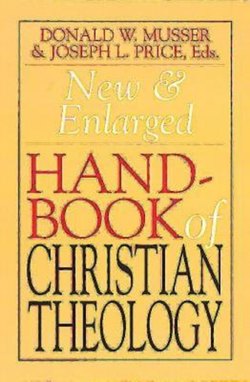Читать книгу New & Enlarged Handbook of Christian Theology - Donald W. Musser - Страница 54
На сайте Литреса книга снята с продажи.
ОглавлениеDISPENSATIONALISM
Dispensationalism is an approach to theology and the Bible that is based on dividing history into “dispensations” or “economies,” which are seen as different phases of God’s progressive revelation. The word comes from the Greek oikonomeo and its derivatives, which are found about twenty times in the New Testament and refer to the management or regulation of a household. When used of God, the word means God’s sovereign plan for the world (see Luke 16:1-2; Eph. 1:10, 3:2, 9; and Col. 1:25).
According to C. I. Scofield, a leading spokesperson for dispensationalism in the early twentieth century, a dispensation is
a period of time during which man is tested in respect of obedience to some specific revelation of the will of God. . . . These periods are marked off in Scripture by some change in God’s method of dealing with mankind, in respect to two questions: of sin, and of man’s responsibility. Each of the dispensations may be regarded as a new test of the natural man, and each ends in judgment—marking the utter failure in every dispensation.
Scofield counted seven such economies: innocence (before the Fall), conscience (the Fall to Noah), human government (Noah to Abraham), promise (Abraham to Moses), law (Moses to Christ), grace or the church age (the period between Christ’s two comings), and the millennial kingdom (after Christ’s return).
John Nelson Darby (1800–1882), an early leader of the Plymouth Brethren in Great Britain, was the first to articulate a complete dispensational theological system. Darby’s dispensationalism grew out of his eschatological views. As a premillennialist, Darby believed that the biblical prophecies of the “last days” were still to be fulfilled and that Christ’s second coming will occur before the beginning of the millennium. Using a strict literalistic hermeneutic, Darby detected in the Bible two distinctly different programs operating in history: one for an earthly people (Israel) and the other for a heavenly people (the church). The key to Darby’s system was keeping these two plans and their respective prophecies completely separate.
In Darby’s view God’s plan for Israel became clear through a series of covenants (with, in sequence, Adam, Noah, Abraham, Moses, and David) that promised redemption through a messiah and the establishment of God’s kingdom on earth. When Jesus was claimed as Messiah, however, the Jews’ rejection of him forced God to postpone the kingdom, turn away from Israel, and raise up a new people from the Gentiles, the church. According to this “postponement theory,” God will not deal again with the Jews until the church is complete and Jesus takes it to heaven in the “rapture” (the “catching up” of believers described in I Thess. 4:17). When this occurs, the “great parenthesis” in prophetic time will end and events of the “last days” will unfold: the great tribulation, the rise of Antichrist, the battle of Armageddon, the second coming, the binding of Satan, and the establishment of the millennial kingdom. This scenario comes from a complicated interpretation of certain apocalyptic prophecies in Ezekiel 37–39, Daniel 7–9, Matthew 24, Mark 13, Luke 21, I Thessalonians 4, II Thessalonians 2, and Revelation. Characteristics of dispensational theology include a firm commitment to biblical inerrancy, a speculative interest in the “signs of the end-time,” and a deep concern for the Jews, who are expected to play an important role in end-time events.
During a number of visits to America in the 1870s, Darby persuaded some prominent evangelical pastors and teachers (including James H. Brookes, William E. Blackstone, James M. Gray, and Scofield) to affirm his theology. Dispensational views spread quickly in conservative evangelicalism through Bible and prophetic conferences, Bible institutes, influential religious journals, and the Scofield Reference Bible (1909, rev. 1967), whose notes explained the biblical texts from a dispensational perspective. Ironically, at the same time that higher critics began to undercut traditional confidence in the Bible, dispensationalists managed to maintain older views of biblical inspiration while arguing that the Bible was incomprehensible apart from a dispensational perspective. By the late-1920s and 1930s, thanks to teachers like Harry Ironside, Arno Gaebelein, and Lewis Sperry Chafer—the movement’s most influential theologian—dispensationalism became almost synonymous with fundamentalism. In the 1970s dispensationalism reached a new audience with Hal Lindsey’s The Late Great Planet Earth, which was the best-selling book of the decade.
Since the mid-1960s dispensationalists have debated the limits of doctrinal development within their system, and they have discussed which elements are nonnegotiable. In Dispensationalism Today (1965), Charles Ryrie argued that the sine qua non of dispensationalism had three aspects: the distinction between Israel and the church, the commitment to the “normal or plain” interpretation of the Bible, and the belief that there was an underlying doxological purpose in all God’s dealings with humanity. But other dispensationalists have challenged his position. It is not unusual now for dispensational theologians to question the complete separation of Israel and the church, the necessity to interpret the Bible literally, and the suitability of using the notion of dispensations as the organizing principle for theology. In short, if the current revisionism continues, dispensationalists will find it difficult to distinguish themselves from other kinds of conservative and evangelical theologians.
TIMOTHY P. WEBER
Bibliography
Craig Blaising, “Development of Dispensationalism by Contemporary Dispensationalists,” Bibliotheca Sacra 145 (July-September 1988): 254-80.
Lewis Sperry Chafer, Systematic Theology, 4 vols.
D. P. Fuller, Gospel and Law.
C. N. Kraus, Dispensationalism in America.
C. C. Ryrie, Dispensationalism Today.
Cross-Reference: Apocalyptic Theology, Eschatology, Fundamentalism, Pentecostalism.
